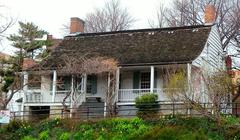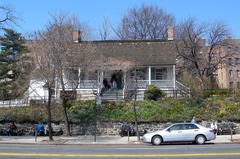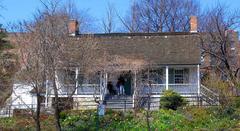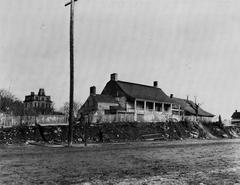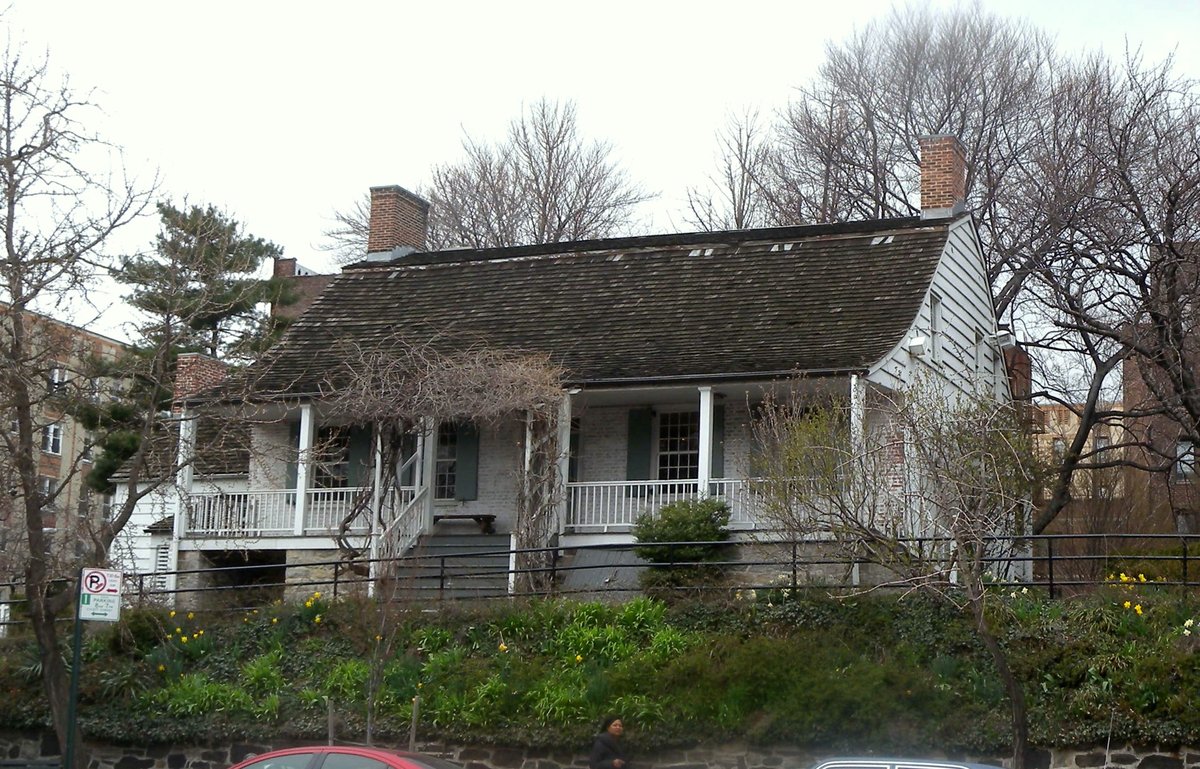
Dyckman House Visiting Hours, Tickets, and New York City Historical Sites Guide
Date: 14/06/2025
Introduction: The Significance of Dyckman House in NYC History
Located in the vibrant Inwood neighborhood at the northern tip of Manhattan, the Dyckman House—officially the Dyckman Farmhouse Museum—stands as Manhattan’s oldest surviving farmhouse and a rare window into New York City’s Dutch colonial heritage. Built around 1784 by William Dyckman, the farmhouse is a testament to 18th-century agrarian life, preserved amid the city’s contemporary urban landscape. Its architecture, featuring hallmark Dutch Colonial elements such as a gambrel roof, spring eaves, and fieldstone foundations, has been meticulously maintained, offering an authentic glimpse into the past.
The museum not only preserves architectural and historical significance, but also serves as a community hub with educational programs, guided tours, and events that highlight Inwood’s multicultural legacy. Its strategic location at 4881 Broadway puts it in close proximity to other notable attractions like Inwood Hill Park and The Cloisters, making it a key stop for anyone interested in New York City’s layered history. The Dyckman Farmhouse Museum is accessible, offers affordable admission, and provides resources such as virtual tours and the Audiala app to engage visitors both onsite and online. For more, visit the Dyckman Farmhouse Museum official website and the NYC Department of Parks & Recreation page.
This guide delivers all essential visitor information, including the site’s history, architectural highlights, visitor logistics, special programs, and tips for exploring nearby attractions.
(Dyckman Farmhouse Museum, The Vintage News, 2019, I Was Here Inwood)
Table of Contents
- Introduction: Discovering Manhattan’s Last Dutch Colonial Farmhouse
- Early History and Construction of Dyckman House
- The Dyckman Family and the Revolutionary War
- Decline and Threat of Demolition
- Restoration and Transition to a Museum
- Dutch Colonial Architecture: Features and Materials
- Cultural Significance and Community Role
- Interior Layout and Furnishings
- Visiting the Dyckman House: Hours, Tickets, and Accessibility
- Guided Tours, Special Programs, and Events
- Museum Layout and Visitor Experience
- Visitor Tips
- Accessibility and Visitor Amenities
- Nearby Attractions and Photographic Spots
- Landmark Designation and Ongoing Preservation
- Visual and Interactive Highlights
- Inclusive Storytelling and Multicultural Programming
- Educational Outreach and Youth Engagement
- Fostering Civic Pride and Neighborhood Identity
- Addressing Contemporary Community Needs
- Frequently Asked Questions (FAQ)
- Plan Your Visit and Stay Connected
Early History and Construction of Dyckman House
The Dyckman House was constructed circa 1784 by William Dyckman, whose family originally settled the area in the 1660s. Built in the Dutch Colonial style, the house features a distinctive gambrel roof, fieldstone and clapboard walls, and broad porches—a testament to the building traditions of early Dutch settlers in New York. The Dyckman family operated a large farm, raising crops and livestock, and their home became a local landmark in rural northern Manhattan.
The Dyckman Family and the Revolutionary War
The Dyckman family’s history is intertwined with the Revolutionary War. Their original homestead was destroyed during the British occupation, prompting a temporary relocation. After the war, William Dyckman rebuilt the farmhouse using some salvaged materials, reestablishing the family’s presence and the role of the farm in northern Manhattan’s recovery.
Decline and Threat of Demolition
Urbanization in the late 19th and early 20th centuries led to the subdivision of farmland and the farmhouse’s decline. Threatened with demolition, the structure was saved through the efforts of Dyckman descendants, notably Mary Alice Dyckman Dean and Fannie Fredericka Dyckman Welch. Their restoration campaign was pivotal in preserving the building for future generations.
Restoration and Transition to a Museum
In 1915, the Dyckman sisters, aided by architect Alexander M. Welch, restored the farmhouse to its late-18th-century appearance. Furnished with family heirlooms and period antiques, it became New York City’s first historic house museum after being donated to the city in 1916. The site has since been designated a New York City Landmark and listed on the National Register of Historic Places.
Dutch Colonial Architecture: Features and Materials
The Dyckman House exemplifies Dutch Colonial architecture with features such as:
- Gambrel Roof: Double-sloped for extra headroom and covered porches.
- Spring Eaves: Projecting roof edges that protect entrances.
- Local Materials: Fieldstone for foundations, brick, and white clapboard siding.
- Wide Porches: Transitional spaces typical of Dutch farmhouses.
- Practical Layout: Simple, functional design reflecting the period.
Restoration efforts have maintained these details, ensuring historical authenticity (Dyckman Farmhouse Museum).
Cultural Significance and Community Role
The museum serves as both a historical landmark and a community anchor:
- Preserves NYC’s Rural Past: The only remaining Dutch Colonial farmhouse in Manhattan.
- Honors Lenape Heritage: Acknowledges the land’s original inhabitants.
- Reflects Multicultural Roots: Addresses the roles of Dutch settlers, enslaved Africans, and later immigrant communities.
- Educational Programs: Offers workshops, school visits, and community events.
- Community Engagement: Hosts concerts, craft workshops, and multicultural celebrations (I Was Here Inwood).
Interior Layout and Furnishings
Inside, visitors encounter narrow hallways, low ceilings, and winding stairs—hallmarks of 18th-century design. The house contains:
- Two parlors, one serving as the museum desk.
- Period rooms furnished with original and authentic Dyckman family artifacts.
- Gardens with heritage plantings and an 18th-century-style smokehouse.
- A reconstructed “Hessian Hut,” illustrating the site’s Revolutionary War history.
Visiting the Dyckman House: Hours, Tickets, and Accessibility
Hours:
- Open Wednesday through Sunday, 12:00 PM – 5:00 PM.
- Closed Monday and major holidays.
- Check the official website for updates.
Tickets and Admission:
- Admission is free.
- Guided tours are available on weekends and by appointment at no cost.
Accessibility:
- The museum is wheelchair accessible, with accommodations available upon request.
- Some historic features may limit access to certain areas; contact staff for specific needs.
Guided Tours, Special Programs, and Events
Guided tours are offered on weekends and by appointment, providing deeper insights into the Dyckman family, Dutch Colonial life, and the transformation of Inwood. The museum hosts a wide variety of events, including:
- Colonial craft workshops
- Harvest and holiday celebrations
- Multicultural music and storytelling programs
- Educational workshops for children and families
(Dyckman Farmhouse Events)
Museum Layout and Visitor Experience
The farmhouse boasts immersive period rooms, interpretive panels, and restored gardens that evoke its agricultural history. Outdoor features like the reconstructed smokehouse and Hessian Hut enrich the narrative. Visitors can also enjoy digital resources and virtual tours for enhanced engagement.
Visitor Tips
- Getting There: Located at 4881 Broadway; accessible via A train (Dyckman Street station) or 1 train (Dyckman Street station); several bus routes serve the area.
- No Onsite Parking: Use public transportation or street parking.
- Wear Comfortable Shoes: Expect uneven paths and historic flooring.
- Photography: Non-flash photography is allowed; flash is prohibited inside to protect artifacts.
- Check Events Calendar: Special programs may enhance your visit.
Accessibility and Visitor Amenities
- Wheelchair access: Most public spaces are accessible; contact the museum for further accommodations.
- Restrooms and Visitor Center: Onsite facilities available.
- No Café: Local dining options are plentiful in Inwood.
Nearby Attractions and Photographic Spots
Combine your visit with other Inwood and northern Manhattan highlights:
- Inwood Hill Park: Trails, scenic vistas, Native American sites.
- Fort Tryon Park: Home to The Cloisters and stunning gardens.
- Little Red Lighthouse: A Hudson River icon.
The farmhouse’s gardens and architecture offer excellent photography opportunities (NYC Metro, Harlem World Magazine).
Landmark Designation and Ongoing Preservation
The Dyckman House was designated a New York City Landmark and added to the National Register of Historic Places in 1967. Restoration projects in the early 2000s further improved its structural integrity and public access. The site is managed by the Dyckman Farmhouse Museum Alliance in partnership with NYC Parks (Landmarks Preservation Commission Report, National Register of Historic Places Listing).
Inclusive Storytelling and Multicultural Programming
The museum actively presents the full scope of Inwood’s layered history, including the stories of enslaved Africans, Dutch settlers, and the area’s evolving immigrant communities. Partnerships, such as with the “I Was Here” project, bring Ancestor Spirit Portraits and other inclusive programs to the site (I Was Here Inwood).
Educational Outreach and Youth Engagement
With nearly a quarter of Inwood’s population under 18, the museum prioritizes youth engagement. Programs range from school visits and summer workshops to family-friendly gardening and crafts, fostering community connections and civic pride (WE ACT Dyckman Report).
Addressing Contemporary Community Needs
The Dyckman Farmhouse Museum hosts environmental workshops, neighborhood meetings, and urban agriculture initiatives, contributing to ongoing conversations about development, gentrification, and sustainability in Inwood (WE ACT Dyckman Report).
Visual and Interactive Highlights
Explore the farmhouse through high-quality images and virtual tours on the museum’s website. Photos and alt tags are optimized for search, featuring terms like “Dyckman House visiting hours,” “Dyckman Farmhouse tickets,” and “Inwood historical sites.”
Frequently Asked Questions (FAQ)
Q: What are the Dyckman House visiting hours?
A: Wednesday through Sunday, 12:00 PM – 5:00 PM. Closed Mondays and major holidays.
Q: Do I need a ticket?
A: Admission is free; guided tours are available on weekends and by appointment.
Q: Is the Dyckman House wheelchair accessible?
A: Yes, with accommodations available upon request.
Q: Can I bring children?
A: Absolutely! The museum offers youth programs and family activities.
Q: Are there special events or seasonal programs?
A: Yes, including holiday celebrations, music events, and craft workshops. See the events page for details.
Q: How do I get there?
A: 4881 Broadway, easily reached via the A or 1 trains (Dyckman Street stations) and local buses.
Q: Can I take photos?
A: Non-flash photography is allowed. No flash or tripods inside.
Q: Are pets allowed?
A: Pets are not permitted inside the museum or gardens.
Plan Your Visit and Stay Connected
Experience the Dyckman Farmhouse Museum firsthand and immerse yourself in Manhattan’s rural past. For the latest updates on hours, tickets, tours, and events, visit the official museum website or email [email protected]. Educational group inquiries: [email protected].
Download the Audiala app for guided audio tours and updates on New York City historical sites. Follow the museum on social media for behind-the-scenes content, event announcements, and community stories.
Summary: Key Points and Visiting Tips
The Dyckman House remains a vital emblem of New York City’s colonial and rural legacy, offering an authentic view of 18th-century farm life alongside robust cultural and educational programming. Its free admission, accessible location, and proximity to other northern Manhattan landmarks make it a must-visit for history enthusiasts, families, and travelers alike. The museum’s commitment to preservation, inclusion, and community engagement ensures that the Dyckman House continues to inspire pride and connect generations to the city’s enduring heritage.
For additional resources and to plan your visit:
- Dyckman Farmhouse Museum official website
- NYC Department of Parks & Recreation: Dyckman House
- Landmarks Preservation Commission Report
- National Register of Historic Places Listing
References
- Dyckman Farmhouse Museum Official Website, 2025
- The Vintage News, 2019, Manhattan Farmhouse
- I Was Here Inwood, Cultural Heritage Project
- NYC Department of Parks & Recreation: Dyckman House
- WE ACT Dyckman Report, 2019
- Harlem World Magazine, Dyckman Legacy and Inwood’s Northern Frontier
- Loving New York, NYC Landmarks

